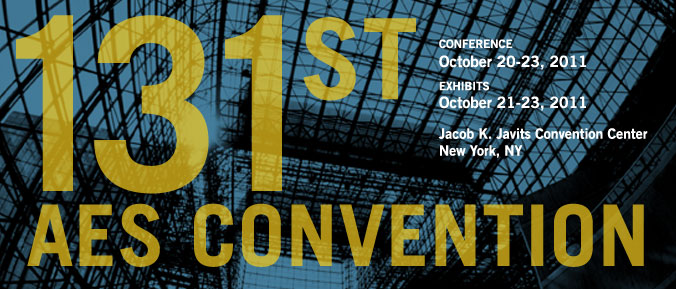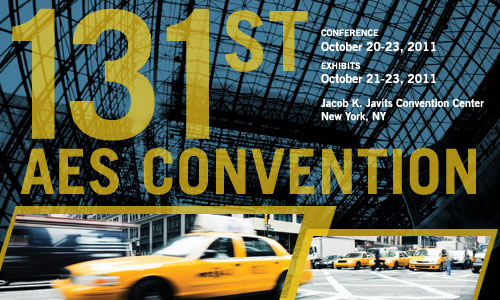
AES New York 2011
Paper Session P1
P1 - Room Acoustics
Thursday, October 20, 9:00 am — 11:00 am (Room: 1E09)
Chair:
Peter Mapp, Peter Mapp Associates
P1-1 New Thoughts on Active Acoustic Absorbers—John Vanderkooy, University of Waterloo - Waterloo, Ontario, Canada
This paper continues an earlier exploration of using full-range loudspeakers as both acoustic sources and sinks, in an attempt to reduce the room decay time for bass frequencies. We develop the theory for a point active absorber immersed in the acoustic source field from a point source. This would apply to normal loudspeakers used as either sources or absorbers at frequencies below about 300 Hz, where they act as points. The result extends the theory of Nelson and Elliott for a point absorber interacting with a plane wave. An extra term occurs that has little net effect when averaged over frequency or distance. In rooms such cancellation occurs due to the varying distances from all the source images to the absorber. Impulse responses in several small rooms were measured from a source and an absorber loudspeaker to both a few listening microphones and a microphone mounted at the absorber. The efficacy of the active absorber is assessed and the results are enigmatic.
Convention Paper 8458 (Purchase now)
P1-2 Investigations of Room Acoustics with a Spherical Microphone Array—Samuel W. Clapp, Rensselear Polytechnic Institute - Troy, NY, USA; Anne Guthrie, Rensselear Polytechnic Institute - Troy, NY, USA, Arup, New York, NY, USA; Jonas Braasch, Ning Xiang, Rensselear Polytechnic Institute - Troy, NY, USA
Most room acoustic parameters are calculated with data from omni-directional or figure-of-eight microphones. Using a spherical microphone array to record room impulse responses can open up several new areas of inquiry. It can yield much more information about the spatial characteristics of the sound field, including the diffuseness of the sound field and the directions of individual reflections. A 16-channel microphone array was designed, built, and tested with both simulations and simple, controlled sound events. Room impulse responses were then measured in reverberant rooms used for music from stage and audience positions, and the results were analyzed using beamforming techniques to determine spatial information about the sound field.
Convention Paper 8459 (Purchase now)
P1-3 Room Acoustics Using a 2.5 Dimensional Approach with Damping Included—Patrick Macey, PACSYS Limited - Nottingham, UK
Cavity modes of a finite bounded region with rigid boundaries can be used to compute the steady state harmonic response for point source excitation. In cuboid domains this is straightforward. In general regions, determining a set of orthonormal modes is more difficult. Previous work showed that for rooms of constant height, 3-D modes can be computed from the cross section modes, and this used for a fast solution. This approach used modal damping. More realistic damping associated with wall areas could be included using a damped eigenvalue calculation of the cross section modes. This is restrictive on damping formulations. An alternative non-modal approach, using a trigonometric expansion through the height is proposed. This is still faster than 3-D FEM.
Convention Paper 8460 (Purchase now)
P1-4 Accurate Acoustic Modeling of Small Rooms—Holger Schmalle, AFMG Ahnert Feistel Media Group - Berlin, Germany; Dirk Noy, WSDG Walters-Storyk Design Group - Basal, Switzerland; Stefan Feistel, AFMG Ahnert Feistel Media Group - Berlin, Germany; Gabriel Hauser, WSDG Walters-Storyk Design Group - Basal, Switzerland; Wolfgang Ahnert, AFMG Ahnert Feistel Media Group - Berlin, Germany; John Storyk, WSDG Walters-Storyk Design Group - Basal, Switzerland
Modeling of sound reinforcement systems and room acoustics in large and medium-size venues has become a standard in the audio industry. However, acoustic modeling of small rooms has not yet evolved into a widely accepted concept, mainly because of the unavailable tool set. This work introduces a practical and accurate software-based approach for simulating the acoustic properties of studio rooms based on FEM. A detailed case study is presented and modeling results are compared with measurements. It is shown that results match within given uncertainties. Also, it is indicated how the simulation software can be enhanced to optimize loudspeaker locations and place absorbers and diffusers in order to improve the acoustic quality of the space and thus the listening experience.
Convention Paper 8457 (Purchase now)
Information Last Updated: 20111005, mei

